You know, when you first hear the name “Golden Triangle,” you immediately think of something romantic: ancient temples, piles of jewels, or at least a geometrically perfect area.
But then you learn the history of this place and realize that it was indeed filled with gold, but in a different sense. It’s a real location on the map, not just a beautiful word in a brochure, where the borders of Thailand, Laos, and Myanmar (also known as Burma) converge.
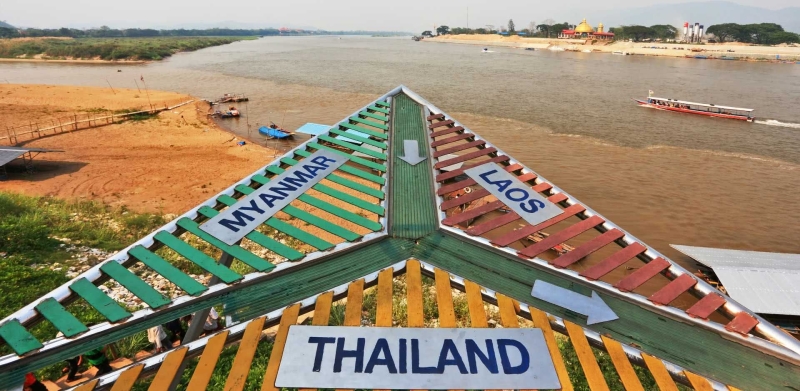
TOP 7 Popular Places in the Golden Triangle of Asia
The region has a colorful history. Once upon a time, opium poppy was grown on an industrial scale here, and the area became famous as a global center for drug trafficking. Times have changed. Today, Thailand has turned this notoriety into a tourist brand, with opium museums that tell the story without embellishment.
It’s a good way to redefine your reputation. Nowadays, people travel to the Golden Triangle for a variety of reasons: the mountainous jungles, the temples, the ethnic villages, the markets where people speak three languages, and the Mekong River that flows through half of Asia. The main thing is that there is still a unique “border” atmosphere where cultures, languages, and destinies blend together.

The Golden Triangle of Asia
Are you ready to find out what’s definitely worth seeing? Let’s go: seven points that will turn your trip into an adventure. And yes, no boring descriptions like those in 90s travel guides.
1. The Confluence of Three Borders: The Heart of the Golden Triangle
Sometimes, the most significant points on a map turn out to be tiny villages. Sop Ruak is just such a small Thai settlement in the Chiang Saen area, about 70 km north of Chiang Rai, which has become a tourist mecca because here the Ruak River flows into the Mekong, forming a natural border between Thailand, Laos and Myanmar.
The main star is a huge golden statue of Buddha Phra Chiang Saen Si Phaendin on a decorative boat at the mouth of the Ruak. There are Buddhist symbols and animal statues nearby, so sunglasses are not a luxury, but a necessity. There is an elephant gate at the foot of the boat, welcoming the guests of the Golden Triangle Park.

Statue of Buddha Phra Chiang Saen Si Phaendin on a decorative boat at the mouth of the Ruak River
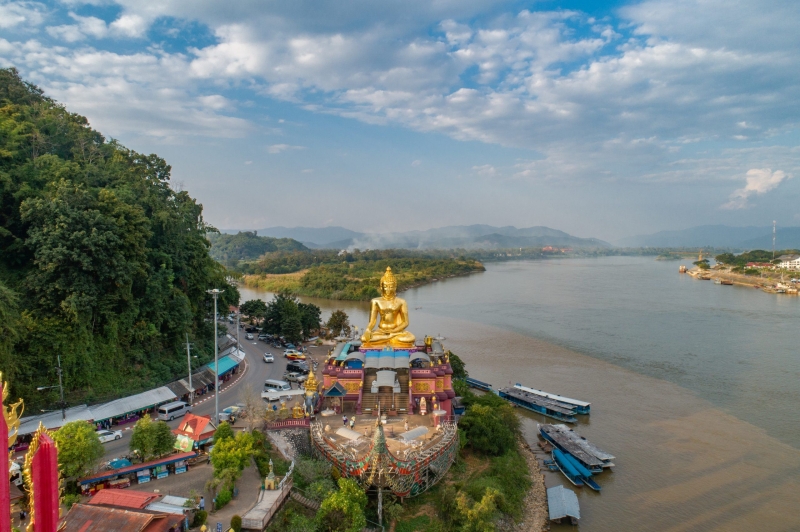
Statue of Buddha Phra Chiang Saen Si Phaendin
The main street winds along the Mekong River and is lined with shops selling local crafts and Laotian products. A fish dinner on the waterfront is a great option at sunset with postcard views of Laos. The backdrop of the village is the hills of Chiang Saen.
Do you want to see the confluence of borders “from above”? Climb to Wat Phra That Doi Pu Khao at the top of the hill. It is believed that it was built by the ruler of Wiang Hirannakhon Ngoen Yang, the capital of the kingdom of Lanna. The chapel and crumbling stupas have been preserved, and the brick viharn has been restored. Two multi-headed Naga snakes guard the entrance near the stairs. The climb is challenging, but the views of the triangle, the Mekong River, and the forested mountains are worth the effort.
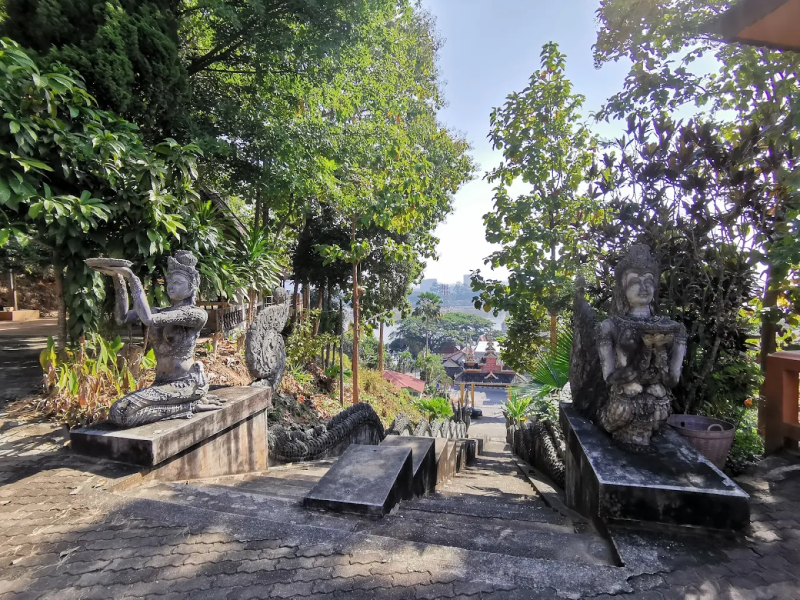
Stairs at Wat Phra That Doi Pu Khao
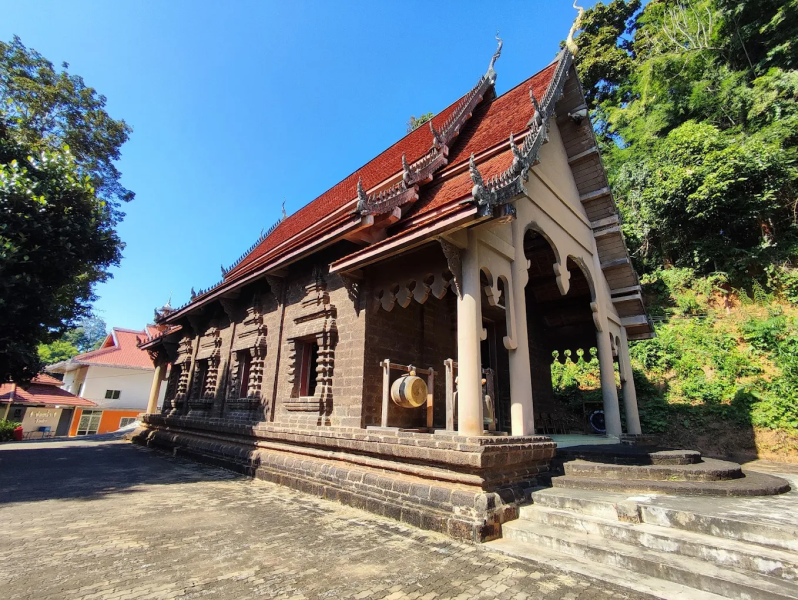
Wat Phra That Doi Pu Khao
A popular activity is a boat ride on the Mekong River with a stop at the Lao market on Don Sao Island (no visa required). The standard route takes about 1 hour: either a speedboat (about 500 baht for a boat with up to 4 passengers) or a slow covered boat (about 1000 baht for a boat with up to 10 passengers). We recommend the second option, which is quieter and more comfortable.
There are border crossings to both Laos and Myanmar. The crossing to Laos is an international checkpoint about 500 meters south of the Golden Triangle monument (the Lao checkpoint is Sam Liam Kham in the Golden Triangle Special Economic Zone, Bokeo Province). The ferry operates from 6:00 a.m. to 8:00 p.m. Thai time. The crossing to Myanmar is about 50 meters west of the monument, where small boats transport visitors across the Ruk River.
The Golden Triangle and its surroundings are safe for tourists: This is a large, well-guarded destination with hotels, restaurants, and markets. The best view of the three countries is not from the monument by the water, but from the top of the hill near the center, which is accessible via a staircase from the Opium House Museum.
2. Wat Rong Khun White Temple: A Dream Come True in Thailand
If the Snow Queen had opened a branch in Southeast Asia, it would have been Wat Rong Khun near Chiang Rai, a symbol of modern North Thai art. Yes, yes, modern: before us is not antiquity, but an impressive “remodel”, which many consider to be one of the most beautiful temples in the country.
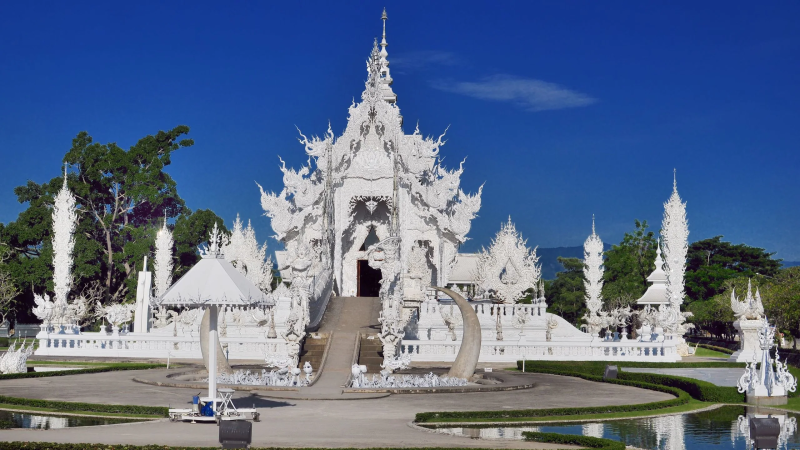
Wat Rong Khun
Construction began in 1997, when the artist Chalermchai Kositpipat decided to use his own money (more than 40 million baht earned from paintings) to completely rebuild the dilapidated temple — and refused sponsors so that no one would dictate the terms. The white color symbolizes the purity of the Buddha, and the mirror inserts represent his wisdom. In the sunlight, everything shines so brightly that it makes you squint: from a distance, it looks like sugar icing or ice, but up close, you can see thousands of hand-carved details.
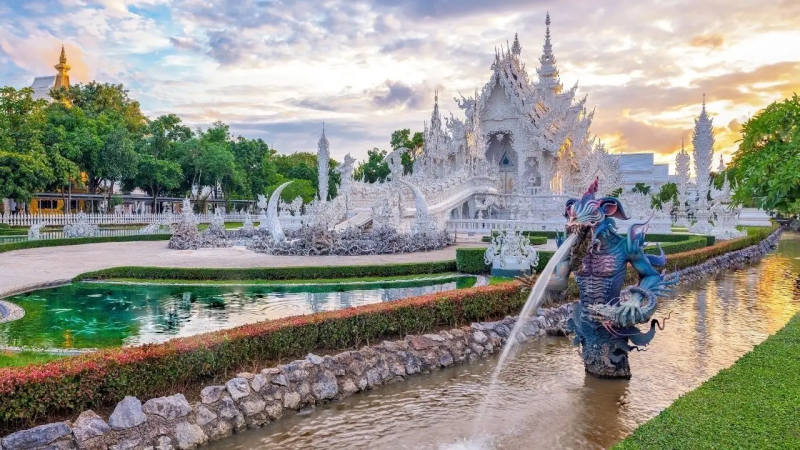
Wat Rong Khun
The route is symbolic: “the world of humans” → the forest of white hands (an allusion to passion and suffering) → the bridge of rebirth, guarded by the Rahu demons → the sanctuary. Inside, there are murals with references to pop culture (“The Matrix”, “Avatar”, “Star Wars”) and contemporary events. You can’t film inside, and that’s for the best. Some things are better experienced than seen on a screen.
In contrast, there’s a golden building, a symbol of the physical and material. And yes, it’s a luxurious public toilet, a subtle touch of irony.
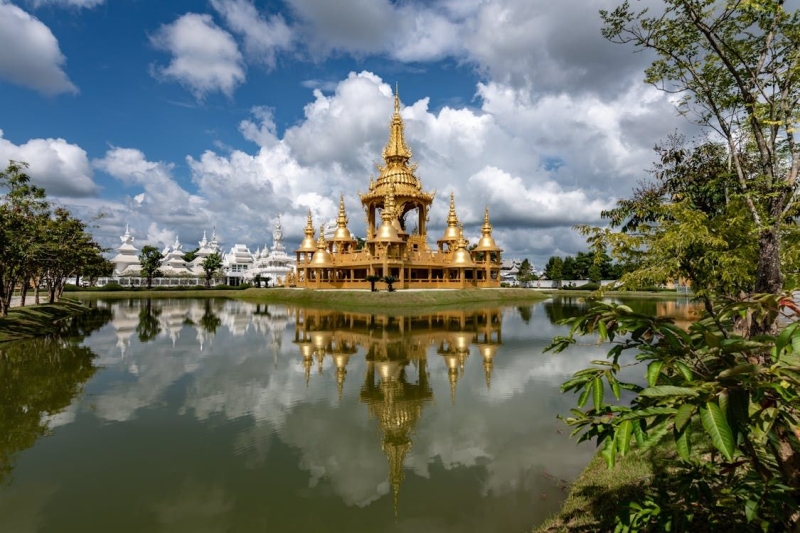
The golden building near Wat Rong Khun (Wat Rong Khun)
The complex consists of nine snow-white buildings (the main temple, the relic hall, the meditation hall, the gallery, and others). The project is scheduled to be completed by 2070. After the 2014 earthquake, the temple was restored.
Practical information: admission for foreigners is 100 baht (free for Thais), and it is open daily from 8:00 a.m. to 5:00 p.m. You can reach the temple by Grab (about 100 baht from the center of Chiang Rai) or by bus (about 20 baht). It’s better to go early in the morning before 9:00 or after 16:00: the light is softer, and there are fewer people. The route through the territory is one-way, and you can’t go back, so take pictures immediately.
3. Luang Prabang: The City of a Thousand Temples in Laos
If the Golden Triangle is a dot on the map, then Luang Prabang is its living heart: a small Laotian city (≈50,000 inhabitants) and the most famous place in the country, included in the UNESCO list for its unique combination of Laotian tradition and French colonial architecture. Sometimes it feels like you’re walking through Asia and then through a provincialFrance.
The name is made up of “luang” – royal, “pha” – Buddha, “bang” – gold; literally – “royal golden Buddha”. Until 1975, the city was the capital of the kingdom of the same name. Located on a peninsula at the confluence of the Khan River in the Mekong – here and the tourist life is concentrated. Temples – really a lot: more than 30 active monasteries.
What to see: Wat Xieng Thong (16th century) is a gem of Lao architecture; Wat Visoun (1513) is the oldest active temple in the city; and the famous Wat Tha That Patum watermelon-shaped stupa. Phu Si (≈100 m) rises above the center, with the Wat Tha Chomsi pagoda (1803). The panoramic views are stunning, and the sunset is crowded, so come for the sunrise.
The main feature is the Tak Bat ceremony (morning feeding of the monks), which has been going on since the 14th century. At dawn, hundreds of monks walk barefoot through the streets, accepting alms. The rules for respectful visits are simple: leave the main street for quieter ones; take rice from the hotel or at the market (not from street vendors), keep your distance, do not cross the path of the monks, take photos without a flash, keep your head below the level of the monks.
Bonus day: Kuang Si Waterfall (≈30 km): 60-meter cascades and turquoise pools where you can swim.
4. Bagan: The Plain of a Thousand Pagodas in Myanmar
The archaeological zone covers an area of ≈104 km² on the dry plateau along the Irrawaddy River. Today, there are approximately 2,200 temples, pagodas, and stupas, most of which date back to the 11th to 13th centuries, when Bagan was the capital of a centralized state. Earthquakes in the 20th century destroyed thousands of structures, and the sloppy restorations of the 1990s prevented the city from being listed by UNESCO until 2019.
Technically, there is no “city of Bagan”: there are the villages of Nyaung-U, Old Bagan, New Bagan, and Myinkaba. Old Bagan has the highest concentration of temples and higher prices, while Nyaung-U and New Bagan have more hotels and cafes.
A visit ticket costs ≈25,000 kyat (about 20 $) and is valid for 5 days. Transportation options include e-bikes (5-10 $/day), bicycles, taxis, or cars. The most “wow” experience is a hot air balloon ride at dawn (starting at 120 $, ~40 minutes): the mist, pagodas, and soft light are a rare sight.
5. Mountain Tribes and Trekking in Chiang Rai
Karen, Akha, Lahu, Lisu, Hmong, and Yao are small peoples of the north, many of whom came from Myanmar in the 20th century. During the opium era, the tribes lived off plantations, but today they rely on tea, coffee, and tourism.
The most well-known are the “long-necked” Karen (Kayan and Padawng). Girls are given rings at a young age, gradually increasing the weight of the “necklace” to 5-6 kg. The aesthetics are controversial, and the comfort is questionable. It is important to keep in mind the ethical considerations: easily accessible “villages” are often turned into attractions, where residents earn almost exclusively from souvenirs, and the entrance fee goes to the treasury. This raises questions about the “human zoo.”
How to do the right thing:
choose small initiatives at the community level and responsible guides;
ask for permission to take photos, dress modestly;
buy products directly from the craftsmen;
avoid begging for photos and aggressive bargaining;
if possible, stay overnight in families as part of ethical tracks (direct income for the hosts).
It is better to do trekking with a guide: the mountains are not a park with signs.
6. The Valley of Jars: A Mystery of Laos
In the province of Xieng Khuang, among the hills and rice fields, there are more than two thousand stone vessels as tall as a person and heavier than a car (up to 6 tons). They are 1,500 to 2,000 years old. The purpose is controversial: are they burial urns? are they storage facilities for water and provisions along the ancient route? There are many theories, but little evidence. There are three sites open to visitors near Phongsavan, with the most popular being “Site 1” with a museum. The region has been affected by bombings: keep an eye out for demining signs.
7. Mandalay: Myanmar’s Cultural Capital
Modern Mandalay is the country’s second-largest city (1+ million inhabitants), with traffic jams and reliable internet access, but the romance remains hidden. There are over 700 pagodas in the city, and the most famous temple is the Mahamuni Temple, which features a four-meter-tall Buddha whose body has been covered in gold leaf for centuries (but not his face).
Sunsets are met on Mandalay Hill (236 m): you can climb barefoot on a covered staircase or take an elevator/car. In clear weather, you can see the Irrawaddy and the hills of Sagaing.
The main highlight nearby is Amarapura and the U Bein Bridge, the longest wooden bridge in the world (≈1200 m) across Lake Taungthaman, built in the 19th century using teak piles. By sunset, it’s a pilgrimage for tourists and boats, and the views are worth it.
Practical information
Visas and documents
Laos: for Russian citizens, visa-free for up to 30 days. Passport must be valid for at least 6 months. From September 1, 2025, an electronic immigration card must be obtained three days before entry (QR code).
Thailand: from July 15, 2024, visa-free for up to 60 days (indefinitely). Extension for 30 days is available at the immigration office for 1,900 baht. Also, an electronic arrival card three days before entry; a passport with a validity period of ≥6 months.
Myanmar: from July 1, 2025, to June 30, 2026, visa-free entry is available for up to 30 days for tourism and business purposes; a mutual visa-free agreement was signed on October 28, 2025. However, due to the ongoing conflict, many areas are closed; entry and exit is through the international airports in Yangon, Mandalay, and Nay Pyi Taw. Please check the current restrictions before traveling.
Money and payment
The most reliable way is to use cash dollars/euros and exchange them on the spot: baht (THB), kip (LAK), and kyat (MMK). The exchange rate at airports is worse; exchange a small amount at the start, and exchange the rest in the city (in Thailand, use Super Rich and other services).
When to go
The best time for the whole region is November–February (dry, 25–30 °C). March–May — hot (up to 35–38 °C), fewer tourists. June–October — rainy season: showers usually in the evening/night, greenery — at its peak, prices lower.
Transport
Between countries it is more convenient to fly; buses — budget, but long. There are bus crossings from Thailand to Laos. Inside: taxis, tuk-tuks, songtheos, and motorbike rentals. In Thailand, Grab is available (often paid in cash), while in Laos, tuk-tuks/mopeds are the easiest option, and in Myanmar, taxis start at around 1,000 kyat.
Safety
Thailand and Laos are generally safe, with standard precautions. In the Valley of the Jars, do not go beyond the “Cleared” signs. Myanmar is more difficult due to the conflict, and parts of Shan State are closed. Check the current recommendations and situation in specific areas before your trip.
Communication and Internet
Thailand has excellent eSIM/SIM cards (for example, packages starting at 399 THB/week). Internet is weaker in Laos, but it works in tourist areas. In Myanmar, the internet is slow, and apps may be blocked, so a VPN is useful.
What to bring
Light, closed-toe shoes for temples, comfortable shoes, a raincoat for the rainy season, repellents, sunscreen, copies of documents, small denominations of cash, and a basic first aid kit.
